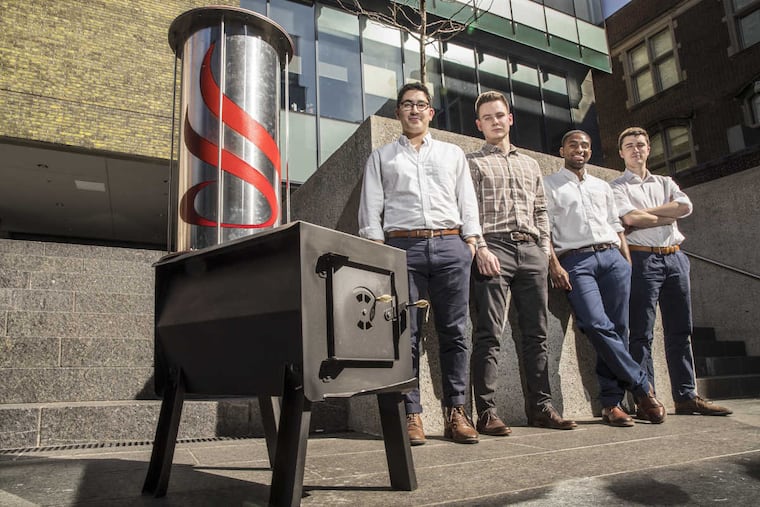This Penn student invention saves energy, could help refugees
Four seniors designed a cylindrical attachment for wood-burning stoves. They say it reduces fuel use by one-third.

The field of engineering gets a lot of attention for the highest of high-tech gadgetry, from flying drones to biomedical implants. But a new invention from a group of University of Pennsylvania seniors illustrates that sometimes, simple is best.
Their magic ingredient? Gravel.
The students' invention is an attachment for wood-burning stoves used in refugee camps – which they say reduces fuel consumption by one-third, thanks to the heat-retaining gravel inside. The young engineers came up with the idea after one, Mazin Blaik, visited a Syrian refugee camp in Lebanon's Bekaa Valley in December.
In winter, when temperatures can dip below freezing, families typically spend $2 a day on wood to keep their tents warm, said Blaik, whose parents were born in Lebanon.
The team estimated that its "Ember" device, created for a senior project at Penn, would shave 60 to 70 cents off that daily fuel bill. And the device would cost less than $70 to make if produced on a mass scale, meaning it would pay for itself in about 100 days, the students said.
"They'd be able to pay it off within one winter," said team member Justin Gonsalves, who is from Montclair, N.J., and is going to work at General Electric after graduation.
Hundreds of thousands of Syrians live in tents in Lebanon, but the device could have far wider use.
"This could be applied to refugee camps anywhere it's cold," said Blaik, who hails from West Philadelphia and is headed to a job at Microsoft.
Yearlong design projects are required of all Penn engineering students. Other innovations this year included Backster, a shirt embedded with orientation sensors to help the wearer maintain good posture, and ShadowDrone, a flying robot that the user can guide with hand gestures.
Usually, such projects aren't commercialized, as students tend to go their separate ways upon graduation.
But in the case of Ember, the students said they might work part-time after graduation to produce it themselves, or more likely they would make the design available to anyone who wanted to use it, such as a global relief organization.
It all started in the fall, when the group, whose other members are Kellen Sanna of Wilton, Conn., and Stephen Michalowski of Philadelphia's Fox Chase section, talked about doing a humanitarian project. Blaik mentioned that his aunt worked on refugee issues for the World Bank.
By December, he was visiting a Syrian camp in Lebanon. The team's initial idea was to design a combination stove for cooking and heating, but Blaik learned that refugees got along well with small diesel-powered stoves for cooking.
The wood-burning heat stoves were another story. They churned out plenty of heat as long as refugees stoked them with fresh wood, but a lot of it went out the stack. And the moment the wood ran out, things cooled off in a hurry.
Blaik came back to Philadelphia, and the team designed a cylindrical container to fit over the exhaust vent of a standard stove, replacing part of the smokestack.
They filled the cylinder with gravel, drawing on the age-old knowledge that rocks are great for retaining heat.
The group also fashioned four mesh tubes inside the cylinder to allow proper airflow.
Some engineering solutions for humanitarian causes have been temporary, because the engineers go home after installation and those who use the devices may not have materials, tools, or know-how to maintain them.
As a result, some refugee camps feature "graveyards" of broken lanterns, cook stoves, and heating devices, said Owen Grafham, a project manager for energy policy at Chatham House, a London-based nonprofit institute.
"Coming up with a technological solution is very important," said Grafham, who gave informal advice to the Penn team. "It really is only half of the solution."
So the Penn team set out to design a low-maintenance product that can be assembled by refugees, with easy-to-follow instructions. The gravel would be obtained on site.
"It's very much like an Ikea package," Blaik said.
The end result is 2.5 feet tall and about 13 inches in diameter. The only maintenance required is cleaning the gravel every few weeks.
Though they have engineering smarts, the team members discovered they were less skilled at firing up a wood stove, initially generating clouds of smoke. The solution?
"You have to get it up to a high temperature right away," Blaik said.
The team tested the stove inside a makeshift tent in the backyard of the Blaik family home in West Philadelphia, which they built with a tarp and two-by-fours.
The students then measured the exhaust coming from the stove with an infrared thermometer. Without the Ember cylinder, the temperature of the exhaust pipe was as high as 500 degrees Fahrenheit. With the attachment, it fell below 200 degrees.
The gravel was doing its job.